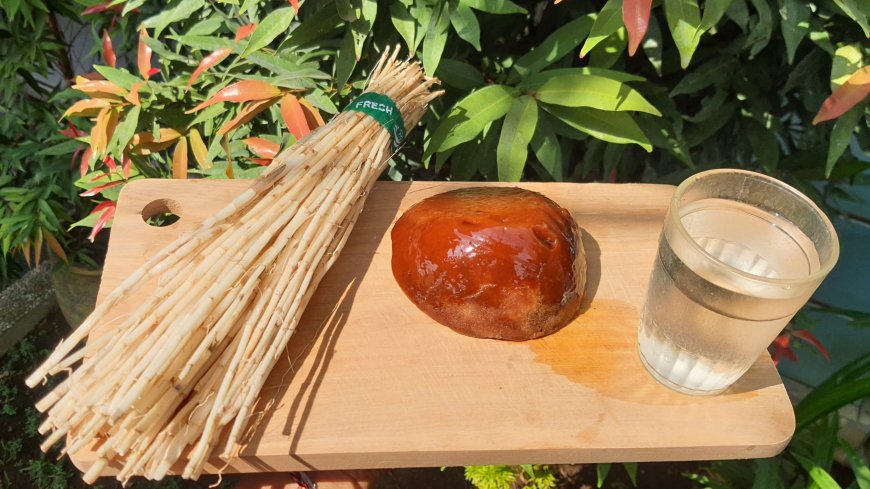Alang-Alang Roots: Traditional Herb for Digestive Health and Wound Healing
Lontar Taru Pramana is one of the most important ancient texts in Usadha Bali, namely the traditional Balinese healing system that has been passed down from generation to generation. This palm oil contains knowledge about various types of medicinal plants and their medicinal properties. One of the plants that is often mentioned in Lontar Taru Pramana is alang-alang root (Imperata cylindrica), which is effective in treating heartburn, urinary tract disorders and bleeding.

Alang-Alang: Wild Plants Used in Traditional Medicine
Alang-alang, or also known as lalang, is a wild plant that is commonly found in various tropical areas. Alang-alang roots are the part most often used in traditional medicine. In palmyra, alang-alang roots are often recommended to treat various conditions because of their ability to soothe the body, stop bleeding, and soothe the digestive system.
Benefits, Processing Methods, and Interesting Facts
Alang-alang roots have various properties in traditional Balinese medicine which are very beneficial for health. Alang-alang root decoction is effective in relieving heartburn and fever, because of its cooling properties which also help reduce inflammation in the body. Apart from that, this root decoction is also often used to relieve digestive disorders such as flatulence, stomach ache, and mild inflammation in the digestive tract. A paste made from the ground root can be used topically on wounds to speed up the blood clotting and healing process, making it a versatile ingredient in Balinese herbal medicine.

Ingredients for processing water from boiled Alang-Alang roots (Photo source: Personal collection)
How to Process Boiled Water from Alang-Alang Roots
1. Wash Clean
The first step is to wash the reed roots thoroughly with running water with the aim of removing dirt stuck to the roots
2. Boil the Alang-alang roots
After washing, put the reed roots into a pan then add 600ml water and boil over medium heat until it boils and half the water remains or around 300ml
3. Add honey or palm sugar
After boiling, remove from heat and strain the boiled water to separate the dregs of the alang-alang roots then add honey or palm sugar to taste as a natural sweetener.

Boiled Water from Alang-Alang Roots (Photo Source: Personal Collection)
Boiled water from reed roots is good to drink when warm 2 times a day in the morning and evening. This boiled water has cooling properties making it effective for relieving internal heat or inflammatory body conditions. Apart from that, the anti-inflammatory properties contained in reeds help reduce inflammation in the digestive tract.

Wound Treatment Processing Material from Alang-Alang Roots (Photo Source: Personal Collection)
How to Process Alang-Alang Roots for Treatment of External Wounds
For wound healing, the roots of alang-alang (Imperata cylindrica) in the Balinese Usadha tradition are often processed into external potions. The only ingredients used are fresh reed roots and clean water. The process of making it is also fairly easy.
1. Wash Clean
The first step is to thoroughly wash the reed roots to remove any dirt and dust attached to them.
2. Crush or puree the roots of the reeds
Next, the washed reed roots are ground coarsely or until fine. If necessary, add a little clean water to help the smoothing process.
3. Apply to the wound
After that, rub or apply pounded reed roots to the injured part of the body or the part that is experiencing minor bleeding.

Alang-Alang Roots for Wound Treatment (Photo Source: Personal Collection)
Alang-alang roots have cooling properties and help speed up blood clotting, making them suitable for small wounds or abrasions. Make sure the wound has been cleaned with clean water before applying this concoction to prevent infection in the wound.
Interesting Facts About Alang-Alang Roots
Alang-alang roots (Imperata cylindrica) have a number of interesting facts that make them popular in traditional medicine. As a natural diuretic, this root can help reduce water retention, facilitate urination, and cleanse the kidneys. Rich in compounds such as silicic acid, mannitol, glucose and saponins, reeds also have the effect of calming the body and reducing inflammation. This plant is even known to be super tough, because it is able to survive in less fertile soil and in extreme environments.
However, the use of reed roots needs to be considered. The strong diuretic effect can cause dehydration if not balanced with enough fluids. In addition, long-term use without supervision can disrupt the body's balance, especially in people with kidney problems or low blood pressure. There is also a small risk of allergies in some people. Although useful for minor complaints, alang-alang cannot replace modern medical care, especially for serious conditions such as serious infections or kidney problems.






























































